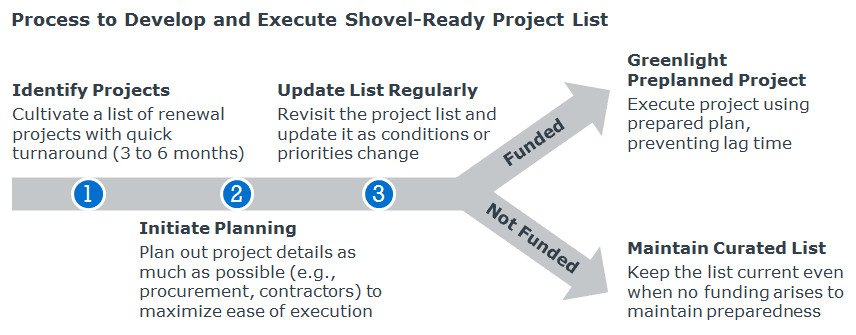Every senior facilities officer recognizes the importance of capital plans. However, these plans are difficult to craft effectively, which may lead to them gathering dust on shelves or becoming outdated quickly.
The challenges and goals of capital renewal planning vary across different time frames, so Facilities leaders must leverage different strategies to create adaptable renewal plans for short-, mid-, and long-term maintenance needs. Especially in an erratic funding environment, creating capital renewal plans that clearly articulate short- and long-term project priorities ensures Facilities optimizes limited capital allocations.
Here are some strategies to ensure a campus’s short-, mid-, and long-term capital plans achieve their respective objectives.
Use short-term plans to strategically spend last-minute funds and build trust
The first type of capital renewal planning focuses on short-term needs (less than one year). Given the complexity and length of most capital renewal projects, Facilities leaders sometimes under-emphasize short-term planning. But preparing for short-range projects is crucial for two reasons:
- Avoid pointless year-end spending. Some institutions operate under restrictive carry-forward policies that require all unspent funds to return to the state or system. This often leads to unproductive year-end spending.
- Build senior leader trust in Facilities. Short-term planning is critical to build senior leader trust. The execution of valuable projects on short notice demonstrates Facilities’ efficiency and preparedness, leading to greater trust and funds in the future.
Process to develop and execute shovel-ready project list
To develop and execute short-term projects, Facilities starts by identifying potential projects with a three- to six-month turnaround. Then Facilities thoroughly plans all project details—such as drafting contracts and emails—to prevent unnecessary delays. Next, Facilities updates the list regularly to reflect changing conditions or priorities. Facilities then either receives funds and executes pre-planned projects or continues to maintain and update the list until funding becomes available.

Lock in Facilities priorities with mid-term plans
The next type of capital renewal planning is for mid-range projects between one and 10 years out. Mid-term horizons are the most common timeframes for capital renewal plans, so many colleges and universities have mastered the basics. However, many institutions can benefit from targeted process improvements around a few areas of their mid-term plans, including:
- Proactively identify funding gaps and match projects with appropriate types of funding. For example, the University of Kansas’s capital renewal plan aligns projects with specific funding sources, such as student fees, state funds, or capital renewal dollars, to help stretch their budget farther. This allows Facilities leaders to ensure that high-priority projects are paired with the most reliable funding streams while restricted funds, such as gifts or tax credits, are used appropriately
- Bundle projects together to reduce cost and speed of execution. This allows Facilities leaders to flag joint departmental endeavors and overlapping projects to increase the feasibility of completing a variety of work. Messiah College was able to fund a much-needed roof renewal as part of a donor-funded project to renovate their gymnasium.
- Update the mid-term plan regularly to reflect changing conditions and priorities. This allows the plan to incorporate the most current information, which increases its value and ability to be executed. Facilities leaders at the University of Arizona meet annually with the CFO to review the capital renewal plan and ensure projects reflect strategic goals.
Uncover future needs early with long-term plans
The last and most challenging type of capital renewal planning is long-range planning, which typically looks beyond the next 10 years. Given the unpredictability of maintenance needs and funding availability, creating reliable long-term renewal plans can be challenging. Nonetheless, this planning allows Facilities leaders to identify potential long-term challenges and make the case that greater stewardship now will reduce future expenses.
One institution that has taken a promising first step toward a long-term plan is the Citadel, The Military College of South Carolina. Their process for building a 40-year capital renewal included mapping out changing building conditions and funding sources to showcase unavoidable long-run costs. This allowed their Facilities leader to make the case for early commitments for capital renewal from stakeholders now to reduce future expenses.